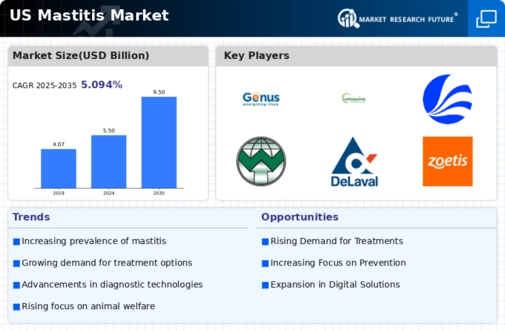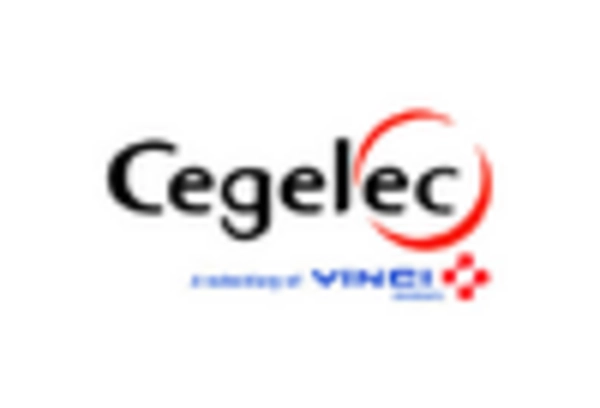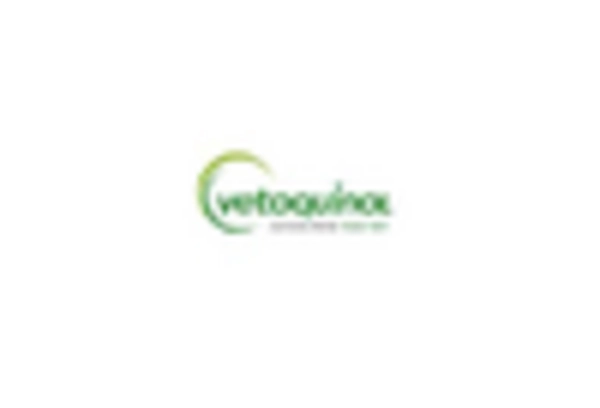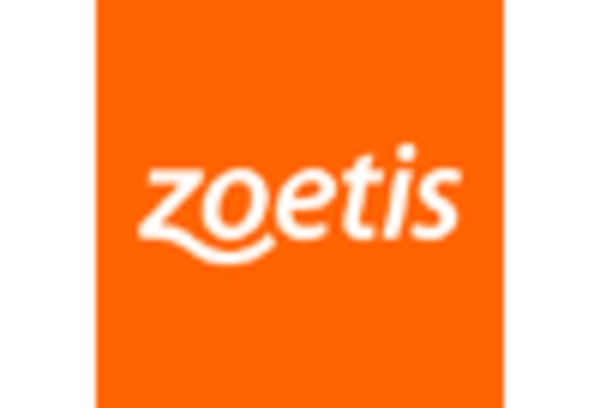The mastitis market exhibits a competitive landscape characterized by a blend of innovation, strategic partnerships, and a focus on sustainability. Key players such as Zoetis (US), Merck Animal Health (US), and Elanco Animal Health (US) are at the forefront, each employing distinct strategies to enhance their market presence. Zoetis (US) emphasizes innovation in product development, particularly in the realm of vaccines and diagnostics, which appears to be a critical driver of their growth. Meanwhile, Merck Animal Health (US) focuses on expanding its portfolio through strategic acquisitions, thereby enhancing its capabilities in addressing mastitis. Elanco Animal Health (US) is also notable for its commitment to sustainability, integrating environmentally friendly practices into its operations, which resonates well with current market demands.
The business tactics employed by these companies include localizing manufacturing and optimizing supply chains to enhance efficiency and responsiveness to market needs. The competitive structure of the mastitis market is moderately fragmented, with several players vying for market share. However, the collective influence of major companies like Zoetis (US) and Merck Animal Health (US) suggests a trend towards consolidation, as these firms leverage their resources to gain a competitive edge.
In October 2025, Zoetis (US) announced a partnership with a leading agricultural technology firm to develop a digital platform aimed at improving mastitis detection and management on dairy farms. This strategic move is likely to enhance Zoetis's product offerings and position them as a leader in digital solutions within the mastitis market. The integration of technology into traditional veterinary practices could significantly improve outcomes for dairy farmers, thereby reinforcing Zoetis's market position.
In September 2025, Merck Animal Health (US) completed the acquisition of a smaller biotech company specializing in mastitis treatment solutions. This acquisition is expected to bolster Merck's product pipeline and expand its reach in the mastitis segment, indicating a proactive approach to enhancing its competitive stance. By integrating innovative treatments into its portfolio, Merck is likely to address unmet needs in the market, thereby attracting a broader customer base.
In August 2025, Elanco Animal Health (US) launched a new line of sustainable mastitis treatment products, which are designed to minimize environmental impact while maintaining efficacy. This initiative aligns with the growing consumer demand for sustainable agricultural practices and positions Elanco favorably among environmentally conscious consumers. The launch reflects a broader trend in the industry towards sustainability, which is becoming a key differentiator in the market.
As of November 2025, the mastitis market is increasingly defined by trends such as digitalization, sustainability, and the integration of artificial intelligence in product development. Strategic alliances among key players are shaping the competitive landscape, fostering innovation and enhancing product offerings. Looking ahead, it appears that competitive differentiation will increasingly pivot from price-based strategies to a focus on innovation, technological advancements, and supply chain reliability, as companies strive to meet evolving consumer expectations and regulatory standards.

















Leave a Comment